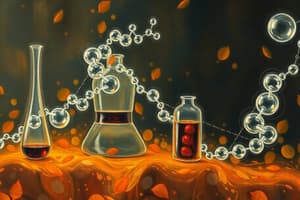Podcast
Questions and Answers
What is the product of the reaction catalyzed by hexokinase?
What is the product of the reaction catalyzed by hexokinase?
- Fructose-6-phosphate
- Glucose-6-phosphate (correct)
- Dihydroxyacetone phosphate
- Fructose-1,6-bisphosphate
Which enzyme catalyzes the conversion of Fructose-6-phosphate to Fructose-1,6-bisphosphate?
Which enzyme catalyzes the conversion of Fructose-6-phosphate to Fructose-1,6-bisphosphate?
- Phosphofructokinase-1 (correct)
- Hexokinase
- Glyceraldehyde-3-phosphate dehydrogenase
- Aldolase
What products are formed from the cleavage of Fructose-1,6-bisphosphate?
What products are formed from the cleavage of Fructose-1,6-bisphosphate?
- Glyceraldehyde-3-phosphate and Dihydroxyacetone phosphate (correct)
- Pyruvate and ATP
- 3-Phosphoglycerate and 2-Phosphoglycerate
- Fructose-6-phosphate and Glucose-6-phosphate
Which reaction is catalyzed by Enolase?
Which reaction is catalyzed by Enolase?
What type of reaction does Phosphoglycerate kinase perform?
What type of reaction does Phosphoglycerate kinase perform?
Flashcards
Glucose to Glucose-6-phosphate
Glucose to Glucose-6-phosphate
Glucose is converted to glucose-6-phosphate by the enzyme hexokinase through phosphorylation.
Glucose-6-phosphate to Fructose-6-phosphate
Glucose-6-phosphate to Fructose-6-phosphate
Glucose-6-phosphate is isomerized into fructose-6-phosphate by the enzyme phosphoglucoisomerase.
Fructose-6-phosphate to Fructose-1,6-bisphosphate
Fructose-6-phosphate to Fructose-1,6-bisphosphate
Fructose-6-phosphate is phosphorylated to fructose-1,6-bisphosphate by phosphofructokinase-1 (PFK-1).
Fructose-1,6-bisphosphate to DHAP and G3P
Fructose-1,6-bisphosphate to DHAP and G3P
Signup and view all the flashcards
1,3-Bisphosphoglycerate to 3-Phosphoglycerate
1,3-Bisphosphoglycerate to 3-Phosphoglycerate
Signup and view all the flashcards
Study Notes
Glycolysis: Key Steps and Enzymes
- Glucose is phosphorylated to Glucose-6-phosphate (G6P) by the enzyme Hexokinase. This is an irreversible step.
- Glucose-6-phosphate (G6P) is isomerized to Fructose-6-phosphate (F6P) by the enzyme Phosphoglucoisomerase.
- Fructose-6-phosphate (F6P) is phosphorylated to Fructose-1,6-bisphosphate (F1,6BP) using ATP by Phosphofructokinase-1 (PFK-1). This is another irreversible step.
- Fructose-1,6-bisphosphate (F1,6BP) is cleaved into Dihydroxyacetone phosphate (DHAP) and Glyceraldehyde-3-phosphate (G3P) by the enzyme Aldolase.
- Dihydroxyacetone phosphate (DHAP) is isomerized to Glyceraldehyde-3-phosphate (G3P) by Triosephosphate isomerase (TIM).
- Glyceraldehyde-3-phosphate (G3P) is oxidized and phosphorylated to 1,3-Bisphosphoglycerate (1,3BPG) by Glyceraldehyde-3-phosphate dehydrogenase.
- 1,3-Bisphosphoglycerate (1,3BPG) undergoes substrate-level phosphorylation, producing 3-Phosphoglycerate (3PG) and ATP using Phosphoglycerate kinase.
- 3-Phosphoglycerate (3PG) is isomerized to 2-Phosphoglycerate (2PG) by Phosphoglyceratemutase.
- 2-Phosphoglycerate (2PG) loses a water molecule (dehydration) forming Phosphoenolpyruvate (PEP) with Enolase.
- Phosphoenolpyruvate (PEP) produces Pyruvate and ATP through substrate-level phosphorylation by Pyruvate kinase.
Studying That Suits You
Use AI to generate personalized quizzes and flashcards to suit your learning preferences.




